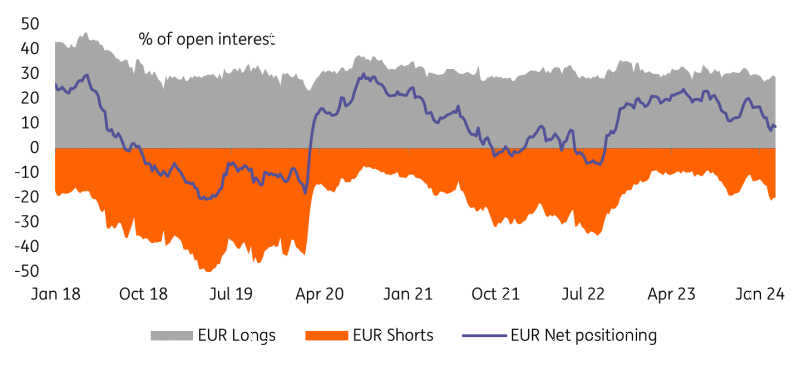We analyse different scenarios ahead of this week's ECB announcement, along with FX and rates implications. As the Bank publishes new staff projections, President Lagarde may start laying out the conditions for easing policy. That may be perceived as slightly dovish, meaning a softer EUR and a re-flattening of the money market curve are tangible risks.
Risks of a modest dovish surprise
Going into the March ECB meeting, the market has taken a more cautious stance towards expected easing from the central bank. In early February, the market had fully discounted two cuts by June. Now, it is not even fully discounting a first cut in June – although with 22bp priced, it still remains the base case. For the year as a whole, the market expects slightly more than 90bp of easing, while in early February, it was looking at closer to 150bp. In sum, it has come off its aggressive pricing and is now not too far from what our economists are expecting from the ECB – a first cut in June with 75bp of easing delivered in total this year.
The governing council also seems to coalesce around June as the date for a first cut, and if the ECB does indeed start to prepare the ground for such an outcome, that could be seen as mildly dovish against the backdrop of more cautious market pricing. A modest re-flattening of the money market curve could be in store as an impact reaction as conviction for the eventual start of the cutting cycle grows again. Longer rates could follow lower, though likely to a lesser degree.
At the same time, the ECB still has enough reasons to keep its guard up and not give away too much at this meeting – not least for the sake of reputational concerns surrounding its inflation-fighting credentials, stressed again by President Christine Lagarde more recently. Central banks will remain in a holding pattern for the coming months, and the slowing progress on bringing down inflation still exerts upward pressure more generally on rates for now to keep them in elevated ranges.
EUR/USD should remain a Dollar story
The possibility that the ECB discusses the conditions for starting to ease policy implies that the balance of risks is slightly titled to the downside for the euro this week. Markets may price in more or earlier rate cuts in the EUR curve, but Lagarde should probably reiterate that there is still missing evidence from the data side and refrain from offering clearer guidance on easing. This means that the impact in FX should not be particularly long-lasting.
In EUR/USD, we could see the dollar leg taking over again rapidly. Markets may be reluctant to take aggressive idiosyncratic EUR positions (in both directions) before seeing the eurozone’s wage and inflation data in March/April, leaving US figures the key catalyst of any material swing in the pair. US payrolls on Friday may well end up having a larger impact on EUR/USD than the ECB announcement.
It is reasonable to expect that FX volatility has bottomed out. March may see some declines in US data sentiment and start to reignite directional trades, but action may be confined among higher-beta currencies, with EUR/USD potentially ending the quarter close to the current 1.08 mark. The euro has a net-long positioning vs the dollar (9% of open interest, according to CFTC data) and a lower sensitivity to risk than other European currencies, making it a more accurate mirror of broader dollar trends. The recent upside surprises in US data may have left a mark on investors, which could require more conclusive evidence on the US inflation and jobs story before structurally turning against the dollar.
EUR/USD net positioning still positive despite recent decline
Source: ING, CFTC, Macrobond
Read the original analysis: March’s ECB cheat sheet: Decoding rate cuts conditionality
Content disclaimer: This publication has been prepared by ING solely for information purposes irrespective of a particular user's means, financial situation or investment objectives. The information does not constitute investment recommendation, and nor is it investment, legal or tax advice or an offer or solicitation to purchase or sell any financial instrument. Read more here: https://think.ing.com/content-disclaimer/
Recommended Content
Editors’ Picks

Gold sits at fresh record high above $3,300 as US Dollar wilts on trade woes
Gold price remains within a striking distance of new record highs above $3,300 on Wednesday. Persistent worries about the escalating US-China trade war and US recession fears revive brroad US Dollar downtrend, boosting the traditional safe-haven Gold ahead of Fed Powell's speech.

EUR/USD holds firm above 1.1350 amid renewed US Dollar weakness
EUR/USD is storngly bid above 1.1350 in European trading on Wednesday. The pair draws support from a fresh round of selling in the US Dollar amid persistent fears over US-China trade war and a lack of progress on EU-US trade talks. US consumer data and Powell speech are in focus.

GBP/USD hangs close to fresh 2025-high above 1.3250 after UK CPI data
GBP/USD holds its six-day winning streak and stays close to its highest level since October above 1.3250 in the European session on Wednesday. The data from the UK showed that the annual CPI inflation softened to 2.6% in March from 2.8% in February but had little impact on Pound Sterling.

Exchange inflows surge as XRP slides, what comes next?
Ripple corrected along with other major digital assets, including Bitcoin and Ethereum, and traded at $2.08 at the time of writing on Wednesday. The drawdown cut across the crypto market, causing the total capitalization to drop 3.2% to $2.736 trillion.

Future-proofing portfolios: A playbook for tariff and recession risks
It does seem like we will be talking tariffs for a while. And if tariffs stay — in some shape or form — even after negotiations, we’ll likely be talking about recession too. Higher input costs, persistent inflation, and tighter monetary policy are already weighing on global growth.

The Best brokers to trade EUR/USD
SPONSORED Discover the top brokers for trading EUR/USD in 2025. Our list features brokers with competitive spreads, fast execution, and powerful platforms. Whether you're a beginner or an expert, find the right partner to navigate the dynamic Forex market.
